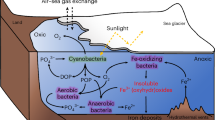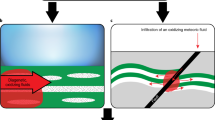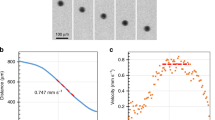Abstract
The chemical signatures and mineralogy of banded iron formations have the potential to provide information about the ocean environment on early Earth1,2,3,4,5,6,7. Their formation requires iron- and silicon-rich fluids, but the mechanisms by which the alternating layers of Si- and Fe-rich rock formed remain controversial8,9,10,11. Here we use thermodynamic calculations to show that Fe- and Si-rich fluids can be generated by hydrothermal leaching of low-Al oceanic crustal rocks such as komatiites. We find that positive feedbacks occur among the chemical reactions when hydrothermal fluids mix with ambient sea water. These feedbacks lead to alternating precipitation of Fe and Si minerals, owing to the formation of complexes between Fe(II) and silicic acid. We suggest that the small-scale (<1 cm) banding was produced by internal dynamics of the geochemical system, rather than any external forcing. As the Archaean eon progressed, the oceanic crust produced was rich in Al12. When Al-rich crust undergoes hydrothermal alteration, Fe is locked in Al–Fe silicate minerals. This results in iron-depleted hydrothermal fluids, and thus prevents the deposition of Fe-rich minerals. We therefore conclude that the widespread cessation of banded iron formation deposition 1.7 billion years ago reflects the changing composition of the oceanic crust.
This is a preview of subscription content, access via your institution
Access options
Subscribe to this journal
Receive 12 print issues and online access
$259.00 per year
only $21.58 per issue
Buy this article
- Purchase on Springer Link
- Instant access to full article PDF
Prices may be subject to local taxes which are calculated during checkout




Similar content being viewed by others
References
Trendall, A. F. The significance of iron-formation in the Precambrian stratigraphic record. 3 Int. Assoc. Sedimentol. Spec. Publ. 33, 33–66 (2002).
Klein, C. Some Precambrian banded iron-formations (BIFs) from around the world: Their age, geologic setting, mineralogy, metamorphism, geochemistry, and origin. Am. Mineral. 90, 1473–1499 (2005).
Ohmoto, H. et al. Chemical and biological evolution of early Earth: Constraints from banded iron-formations. Geol. Soc. Am. Memoir 198, 291–331 (2006).
Canfield, D. E. The Early History of atmospheric oxygen: Homage to Robert M. Garrels. Annu. Rev. Earth. Planet. Sci. 33, 1–36 (2005).
Konhauser, K. O. et al. Oceanic nickel depletion and methanogen famine before the great oxidation event. Nature 458, 750–754 (2009).
Meyer, C. Ore metals through geologic history. Science 227, 1421–1428 (1985).
Johnson, C. M., Beard, B. L., Klein, C., Beukes, N. J. & Roden, E. E. Iron isotopes constrain biologic and abiologic processes in banded iron formation genesis. Geochim. Cosmochim. Acta 72, 151–169 (2008).
Drever, J. I. Geochemical model for the origin of Precambrian banded iron formations. Geol. Soc. Am. Bull. 85, 1099–1106 (1974).
Garrels, R. M. A model for the deposition of the microbanded Precambrian iron formations. Am. J. Sci. 287, 81–106 (1987).
Posth, N. R., Hegler, F., Konhauser, K. O. & Kappler, A. Alternating Si and Fe deposition caused by temperature fluctuations in Precambrian oceans. Nature Geosci. 1, 703–708 (2008).
Krapez, B., Barley, M. E. & Pickard, A. L. Hydrothermal and resedimented origins of the precursor sediments to banded iron-formation: Sedimentological evidence from the Early Palaeoproterozoic Brockman Supersequence of Western Australia. Sedimentology 50, 979–1011 (2003).
Arndt, N. T., Lesher, C. M. & Barnes, S. J. Komatiite (Cambridge Univ. Press, 2008).
Kasting, J. F. & Howard, M. T. Atmospheric composition and climate on the early Earth. Phil. Trans. R. Soc. B 361, 1733–1742 (2006).
Condie, K. C. Plate Tectonics & Crustal Evolution 3rd edn (Pergamon, 1989).
Bebout, B. M. et al. Methane production by microbial mats under low sulphate concentrations. Geobiology 2, 87–96 (2004).
Martin, W., Baross, J., Kelley, D. & Russell, M. J. Hydrothermal vents and the origin of life. Nature Rev. Microbiol. 29, 1–10 (2008).
Isley, A. E. & Abbott, D. H. Plume-related mafic volcanism and the depeosition of banded iron formation. J. Geophys. Res. 44, 15461–15477 (1999).
Isley, A. E. Hydrothermal plumes and delivery of iron to banded iron formation. J. Geol. 103, 169–185 (1995).
Poulton, S. W., Fralick, P. W. & Canfield, D. E. The transition to sulphidic ocean ∼1.84 billion years ago. Nature 431, 173–177 (2004).
Beard, J. S. Geological Society of America Meeting (Houston, 2008).
Merino, E. & Wang, Y. in Non-Equilibrium Processes and Dissipative Structures in Geoscience, Self-Organization Yearbook Vol. 11 (eds Krug, H.-J. & Kruhl, J. H.) 13–45 (Duncker & Humblot, 2001).
Nicolis, G. & Prigogine, I. Self-Organization in Non-Equilibrium Systems (Wiley, 1977).
Sung, W. & Morgan, J. J. Kinetics and product of ferrous iron oxygenation in aqueous systems. Environ. Sci. Technol. 14, 561–568 (1980).
Millero, F. J., Sotolongo, S. & Izaguirre, M. The oxidation kinetics of Fe(II) in seawater. Geochim. Cosmochim. Acta 51, 793–801 (1987).
Simonson, B. M. Origin and evolution of large Precambrian iron formations. Geol. Soc. Am. Spec. Paper 370, 231–244 (2003).
Wolery, T. J. & Jarek, R. L. EQ3/6, A Software Package for Geochemical Modeling of Aqueous Systems Vol. 8.0 (Sandia National Laboratories, 2003).
Thakur, P., Singh, D. K. & Choppin, G. R. Polymerization study of o-Si(OH)4 and complexation with Am(III), Eu(III) and Cm(III). Inorg. Chim. Acta 360, 3705–3711 (2007).
Wang, Y. & Xu, H. Prediction of trace metal partitioning between minerals and aqueous solutions: A linear free energy correlation approach. Geochim. Cosmochim. Acta 65, 1529–1543 (2001).
Xu, H., Wang, Y. & Barton, L. L. Application of a linear free energy relationship to crystalline solids of MO2 and M(OH)4 phases. J. Nucl. Mater. 273, 343–346 (1999).
Acknowledgements
Sandia is a multiprogram laboratory operated by Sandia Corporation, a Lockheed Martin Company for the United States Department of Energy’s National Nuclear Security Administration under contract DE-AC04-94AL85000. This work is partly supported by DOE Sandia LDRD Program and NASA Astrobiology Institute under grant N07-5489 and NSF (EAR-0810150). The authors thank C. Jove-Colon and C. Bryan of Sandia National Laboratories, C. Klein of University of New Mexico, K. C. Condie of New Mexico Institute of Technology and P. Brown, E. Roden, C. Johnson and J. Valley of the University of Wisconsin for their comments on an early draft of this paper and M. Diman for the artwork of Fig. 1. H.X. also thanks D. F. Blake of NASA Ames Research Center, D. Ojakangas of the University of Minnesota-Duluth, P. Fralick of Lakehead University, P. Pufahl of Acadia University and Alumni Geology Field Experience Fund of the Department of Geology and Geophysics of University of Wisconsin for their help with a field trip and C. Klein of University of New Mexico for donating his BIF collection.
Author information
Authors and Affiliations
Contributions
Y.W. and H.X. formulated the model and Y.W. drafted the paper; E.M. contributed to conceptual model development and part of the writing; H.X. and H.K. provided the Supplementary Information.
Corresponding author
Supplementary information
Supplementary Information
Supplementary Information (PDF 492 kb)
Rights and permissions
About this article
Cite this article
Wang, Y., Xu, H., Merino, E. et al. Generation of banded iron formations by internal dynamics and leaching of oceanic crust. Nature Geosci 2, 781–784 (2009). https://doi.org/10.1038/ngeo652
Received:
Accepted:
Published:
Issue Date:
DOI: https://doi.org/10.1038/ngeo652



